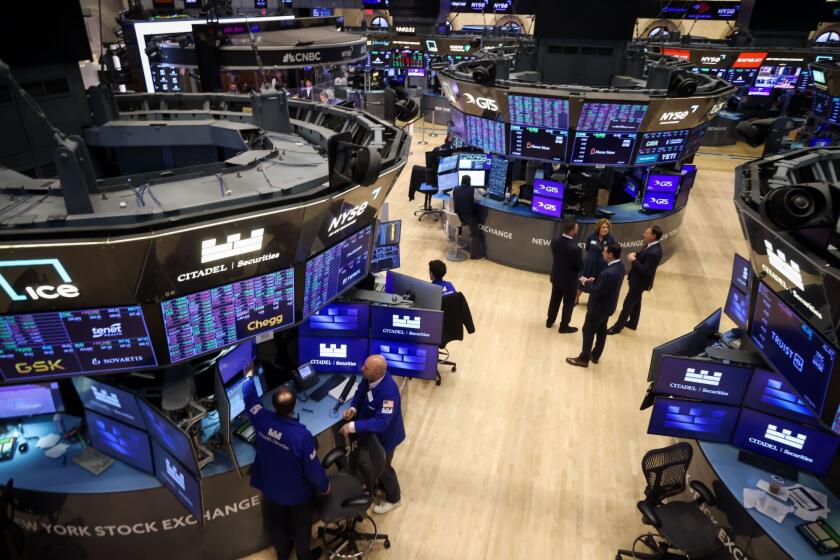Disney’s Learning Lab : Despite Glitches, Euro Disneyland a Big Draw
- Share via
MARNE-LA-VALLE, FRANCE — The African food is definitely not working, and the nightly fireworks displays will soon be scrubbed since dusk arrives here about the time we’re used to flicking on late-night news.
Debunked, too, have been expectations that Europeans would enjoy long leisurely meals. Inside Euro Disneyland, where some restaurant managers were waiting with covered tables and upscale food, guests instead have been running to fast-food counters for hamburgers, hot dogs and soft drinks.
And sometimes just trying to communicate with the more than 15,000 employees who speak a total of 63 languages has been a challenge worthy of United Nations intervention.
“We don’t ask them (employees) to speak English here,” Disneyland International President James Cora said Thursday. “We tell them to just speak Disney.”
Yet nearly a month after the entertainment company swung open its gates on a $4-billion European gamble, officials say they are on line to meet first-year attendance projections of 11 million visitors.
“Of all the projects we have been involved with, this one has worked best for us,” said Cora, who has headed development of all four Disney parks. “But we still have some fixing to do.”
Lessons learned here might someday be incorporated into the planned $3-billion expansion of Disneyland in Anaheim. This week, a delegation of 77 civic and business leaders from Anaheim are touring Euro Disneyland for a look into that future.
Cora, whose company is not prone to releasing attendance figures, said daily crowds have ranged from midweek lows of 20,000 to weekend highs pushing 60,000 guests. Disney needs to average about 30,000 visitors per day to meet its expectations.
Disney is racking up the numbers largely because of the streams of tourists from Great Britain, Germany, Italy and Spain, everywhere in Europe, it seems, except in the theme park’s home country, park officials said. Since some French loudly criticized the Disney invasion as a cultural affront even before construction began, the numbers are not a complete surprise but could signal long-term concerns.
Pre-opening broadcasts of massive traffic jams and overwhelming crowds that never materialized apparently did not help matters with prospective Paris guests and those from the surrounding regions.
Throughout its opening days, Disney executives said they have been aggressively attempting to measure attitudes among the French by using phone banks and surveyors moving among park guests soliciting answers to survey questions.
Even with French attendance down, Cora said he has been encouraged with the company’s in-house survey results, which reportedly show that among those French who have plunked down the $40 ticket charges, 85% said they would return and 90% said they would recommend the experience to a friend.
“Gee, I would say if you took the average man on the street he would be looking forward to being entertained,” Cora said. “Then you have the so-called intellectuals. I don’t know what they imagined we were going to do here.”
While the government has been largely supportive, both politically and financially, Cora said he is hopeful that as the weather warms, so will the French people to the uniquely American brand of entertainment.
With Paris a good 20 miles to the west, some of the more vocal criticism has come from the handful of villages whose former farmlands now support luxury resort hotels.
Francois Bentz is the mayor of Coupvray--population 2,500--whose town is only six minutes away from the front gates of Disney’s massive Newport Bay Club Hotel.
Bentz estimates that in three years, because of the French government’s push to develop Paris’ east side and the presence of Euro Disneyland, total population in the five surrounding villages will triple to 13,000. By 2002, the number could reach 35,000, the mayor said.
“I have no real problem with Disney, but this kind of growth is a big mistake,” Bentz said. “There has been nothing done to make services possible for 30,000 people here.”
Even though a rail station has been extended to Disney’s gates and in proximity to Coupvray and the towns of Chessy, Serris, Bailly and Magny, Bentz said rush-hour trains into Paris are routinely jammed with commuters. He says that Disney has been largely unaffected by crowding, since its employees and guests travel in the opposite direction.
Disney’s presence has also served to disrupt the town’s presence as a quiet haven for those who years ago sought refuge from the busy streets of Paris, Bentz said.
“It was so quiet here before,” the mayor said. “Now you can hear the whistle of that little choo-choo train (the Euro Disneyland Railroad) all day. It drives the people crazy.”
The French villagers’ concerns bear remarkable resemblance to those expressed by Anaheim residents living near the park who have since grudgingly come to accept fireworks that light the night skies over their neighborhoods just before the park closes.
“They told us that in Anaheim no one complains and houses are even closer,” Bentz said of his recent complaints about the Euro Disneyland fireworks.
Nicolas de Schonen, Euro Disneyland’s corporate communications manager, said the company has been sensitive to the residents’ complaints. Roads were constructed on park grounds so that Disney traffic would not clog local streets, and landscaping buffers have been planted on the park’s borders.
And by Bentz’s own accounting, his tiny village, which now contains Euro Disneyland’s Newport Bay Club, Sequoia Lodge, Hotel Santa Fe and Hotel Cheyenne, could receive an additional $2 million in property taxes.
“These are going to be among the richest villages in France,” de Schonen said.
Inside the park, Cora said, he has been pleased with the overall acceptance of the attractions, hotels and low turnover among employees. Frontierland has been, by far, the most popular.
Occupancy rates in the park’s five hotels (the sixth is set to open by the end of the month) hover between 50% and 70%, and Cora expects those numbers to increase as the summer approaches.
One disappointment, however, has been the collection of restaurants and shops just outside the theme park known as Festival Disney. Distinguished by their heavily American themes, the shops include the Hollywood Surf Shop, Carnegie’s Sports Bar and Deli and Annette’s Diner.
“It’s a fun place, but it just hasn’t caught on,” Cora said, adding that executives have toyed with changing the name.
But the real concern here is for bringing a return on investment, and that means keeping attendance up.
Probably the park’s most intensive marketing campaign has involved a team of Disney workers, who since March have been hauling a replica of Euro Disneyland’s Le Chateau de la Belle au Bois Dormant (Sleeping Beauty’s Castle) throughout Europe promoting the opening.
The castle replica--about half the size of the real thing--is carted in a convoy of tractor-trailer trucks and can be assembled in a night. It has made appearances throughout France, Germany and Holland and will be making future visits to Italy and Spain.
Complete with a fireworks display, de Schonen said the castle has drawn good-size crowds at virtually every stop.
“We’re running better than expected,” Cora said. “I’m afraid to do too much changing in just a month. A month gives me only about a third of the information I need. I’ll need a full summer and full winter to really know.”
More to Read
Inside the business of entertainment
The Wide Shot brings you news, analysis and insights on everything from streaming wars to production — and what it all means for the future.
You may occasionally receive promotional content from the Los Angeles Times.










